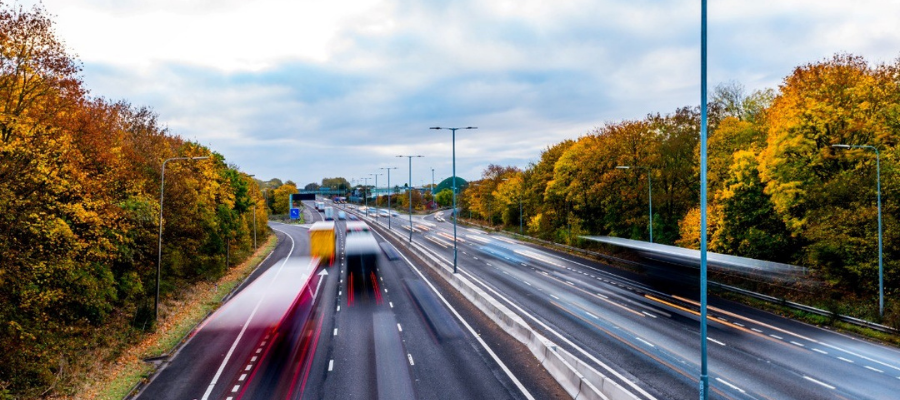🕒 Article read time: 2 minutes
Could smart street lighting help usher in an autonomous future?

Imagine driving an HGV in a platoon formation along a motorway, knowing that your vehicle’s ability to communicate was neatly stored inside the lanterns of the street lighting lining the road.
This could become a reality, according to new research commissioned by National Highways (formerly Highways England).
The government-owned company, charged with operating, maintaining and improving motorways and major A roads in England, maintains that teh research proves how street lighting could be used to pave the way for autonomous vehicles in the future.
SHEDDING LIGHT ON TRAFFIC MOVEMENTS
Closed circuit television and wireless technology enabling vehicles to communicate could nestle inside the lanterns of street lights alongside National Highways’ network. In the future, this could enable the existing infrastructure to issue information on traffic updates, speed limits and diversions – helping vehicles to plan journeys more effectively.
Although street lighting has long been viewed as a standalone asset, emerging technology could revolutionise its role, transforming it into an integral part of the highways network’s digital infrastructure.
In the past, bandwidth has restricted air wave transmissions. That has all changed with the rollout of 5G and the IoT (Internet of Things) infrastructures. Lighting could shortly be equipped with devices such as wireless access points and cameras.
TRIALLING THE TECH
A ‘proof of concept’ trial, dubbed Illuminate, on this intelligent street lighting has been carried out on the M40 junction 15 Longbridge roundabout near Birmingham. As it was installed when the lights were switched to the improved, greener LED lighting, drivers would have been oblivious to the CCTV and communications technology hidden away in the street lamps. The trial took place over five months last year and successfully proved the concept, with the technology able to communicate data to office equipment and tablet computers.
INFORMING NATIONAL HIGHWAYS STRATEGY FOR AUTONOMOUS VEHICLES
The knowledge gained in the trial will be used to help inform National Highways’ strategy for Connected and Autonomous Vehicles (CAV) infrastructure.
National Highways is looking for technologies that can effectively support autonomous vehicles so they can push and receive messages across the network. These messages could be about speed limits, incidents, updates on clearance times – useful information to help drivers plan their journeys. This would involve a large-scale deployment of technology across the network and street lights could be the answer.
“These are exciting times as we progress on our Digital Roads journey with the growth of digital technology and the move to electric, connected and autonomous vehicles that will fundamentally change how we use roads in the future,” said Lisa Maric, National Highways’ Innovations Lead for the Midlands.
“National Highways is committed to ensuring we are at the forefront of this digital revolution and are preparing the way for the greener and safer roads of tomorrow.
“Initial trials such as Illuminate will help us identify new innovations, technology and methods to meet our digital goals. We were pleased with how Illuminate performed as a proof of concept and the useful knowledge gained as we continue to plan for the roads of the future.”
BETTER VALUE AND LESS DISRUPTIVE WAY OF INSTALLING TECH
National Highways worked with Kier Highways on the Illuminate trial. Commenting on the proof-of-concept project, Kier Highways Project Manager, Carla Vicente, said:
“Being able to install technology, such as CCTV, while we are replacing street lighting is a more efficient way of working and provides better value for customers. More importantly, it is a safer and less disruptive way of working, reducing the amount of road closures required.
“This proof of concept will feed into other future projects and the learnings will help to deliver more collaborative and sustainable projects, which supports National Highways’ Carbon Net Zero targets.”
The trial has been funded through National Highways’ Innovation and Modernisation Fund which is helping to maximise the opportunities offered by developments such as automated vehicles while putting safety at the forefront of emerging technologies.
James Firth, Head of Road Freight Regulation, Logistics UK, said: “This proof-of-concept trial by National Highways offers an early glimpse of a new era of increased digital connectivity for all motorists. Given the trial’s potential to pave the way for connected and autonomous vehicles to travel on England’s motorways in the near future, it will be of particular interest to haulage operators looking to modernise and decarbonise their fleets.”
*www.logistics.org.uk/road
Published On: 27/01/2022 16:00:23

Comments Section
If you are a Logistics UK member login to add comments.